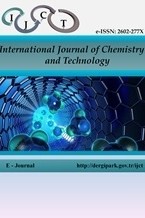Antifungal effect of some essential oil combinations
Antifungal effect of some essential oil combinations
Antifungal effect, Essential oil Fennel, Laurel,
___
- Ghabraie, M., Vu, K.D., Tata, L., Salmieri, S. and Lacroix, M., 2016. Antimicrobial Effect of Essential Oils in Combinations Against Five Bacteria and Their Effect on Sensorial Quality of Ground Meat LWT-Food Science and Technology, 66, 332-339.
- Conner, D.E. and Beuchat, L.R., 1984. Effects of Essential Oils from Plants on Growth of Food Spoilage Yeasts. Journal of Food Science, 49, 29–434.
- Deans, S.G. and Ritchie, G., 1987. Antibacterial Properties of Plant Essential Oils. International Journal of Food Microbiology, 165-180.
- Beuchat, L.R., 1994. Antimicrobial Properties of Spices and Their Essential Oils. In Natural Antimicrobial Systems and Food Preservation, V.M. Dillon and RG Board (Eds.), CAB International Wallingford, UK, 167–180.
- Delaquis, P.J., Stanich, K., Girard, B. and Mazza, G., 2002. Antimicrobial Activity of Individual and Mixed Fractions of Dill, Cilantro, Coriander and Eucalyptus Essential Oils. International Journal of Food Microbiology, 74, 101–109.
- Çalık, A. Gece Academy. Innovative Approaches in Agriculture, Forestry and Aquaculture Sciences. 2018, 101-105.
- Çalık, A. Turkish JAF Sci.Tech., 2020, 8(3): 728-732.
- Paster, N., and Bullerman, L.B., 1988. Mould Spoilage and Mycotoxin Formation in Grains as Controlled by Physical Means. International Journal of Food Microbiology, 7, 257−265.
- Soylu, E.M., Tok, M.F., Soylu, S., Kaya, A.D., and EvrendileK, G.A., 2005. Antifungal Activities of the Essential Oils on Post-Harvest Disease Agent Penicillium digitatum. Pakistan Journal of Biological Sciences, 8, 25-29.
- Soylu, S., Yigitbas, H., Soylu, E.M. and Kurt, S., 2007. Antifungal Effects of Essential Oils from Oregano and Fennel on Sclerotinia sclerotiorum Journal of Applied Microbiology, 103, 1021–1030.
- Altinok-Yipel, F. and Yipel, M., 2014. Etno Veteriner Hekimlik (EVH). Türk Veteriner Hekimler Birliği Dergisi, 1(2): 79-82.
- Burt, S., 2004. Essential oils: Their Antibacterial Properties and Potential Applications in Foods-a review. International Journal of Food Microbiology, 94, 223–253.
- Toroğlu, S. and Cenet, M., 2006. Tedavi Amaçlı Kullanılan Bazı Bitkilerin Kullanım Alanları ve Antimikrobiyal Aktivitelerinin Belirlenmesi İçin Kullanılan Metodlar. KSÜ Fen ve Mühendislik Dergisi, 9(2), 12-20.
- Edris, A.E. and Farrag, E.S., 2003. Antifungal Activity of Peppermint and Sweet Basil Essential Oils and Their Major Aroma Constituents on Some Plant Pathogenic Fungi from the Vapour Phase. Nahrun/⁄Food, 47, 117–121.
- Kalemba, D. and Kunicka, A., 2003. Antibacterial and Antifungal Properties of Essential Oils. Current Medicinal Chemistry, 10, 813-829. http://dx.doi.org/10.2174/0929867033457719.
- Pitarokili, D., Tzakou, O., Loukis, A. and Harvala, C., 2003. Volatile Metabolites from Salvia fruticosa as Antifungal Agents in Soilborne Pathogens. J Agric Food Chem, 51, 3294–3301.
- Kara, M., Soylu, S., Türkmen, M. and Kaya D.A., 2020. Determination and antifungal activities of laurel and fennel essential oils against fungal disease agents of cypress seedlings. Journal of Tekirdag Agricultural Faculty, 17(2), 264-275, doi: 10.33462/jotaf.663452.
- Niculescu, O., Gaidau, C., Simion, D. and Daniela Berechet, M., 2020. The Study on the Possibility of Using Ecological Materials with Antifungal Properties for Treating Natural Leathers. REVISTA DE CHIMIE(Bucharest), 71(1), 445-449.
- Deleanu, M., Popa, E.E. and Popa M.E., 2018. Chemical Composition and Active Properties Evaluation of Wild Oregano (Origanum vulgare) and Ginger (Zingiber officinale-Roscoe) Essential Oils. REVISTA DE CHIMIE(Bucharest), 69(8), 1927-1933.
- Koçer, O, Ayanoğlu, F . (2021). Dişi Defne (Laurus nobilis L.) Genotiplerinde Meyve Yağ Asitleri Kompozisyonlarının Belirlenmesi . Uluslararası Doğu Anadolu Fen Mühendislik ve Tasarım Dergisi , 3 (1) , 72-88 . DOI: 10.47898/ijeased.843773.
- Ayanoğlu, F , Kaya, D , Koçer, O . (2018). Promising bay laurel (Laurus nobilis L.) genotypes for fruit production . International Journal of Chemistry and Technology , 2 (2) , 161-167 . DOI: 10.32571/ijct.485896.
- Yayın Aralığı: Yılda 2 Sayı
- Başlangıç: 2017
- Yayıncı: İbrahim DEMİRTAŞ
The activity of ceria supported complex in hydrogen generation
Burçin TÜRKMENOĞLU, Yahya GÜZEL
Mehmet Şakir ECE, Sinan KUTLUAY, Ömer ŞAHİN
Hydrogen generation by hydrolysis of ammonia borohydride using the Nano-Bimetallic catalyst
Esvet AKBAŞ, Murat OKAY, Erdem ERGAN, Begüm Çağla AKBAŞ
Antifungal effect of some essential oil combinations
Bedriye Seda KURŞUN AKTAR, Ayşe ŞAHİN YAĞLIOĞLU, Emine Elçin ORUÇ-EMRE
